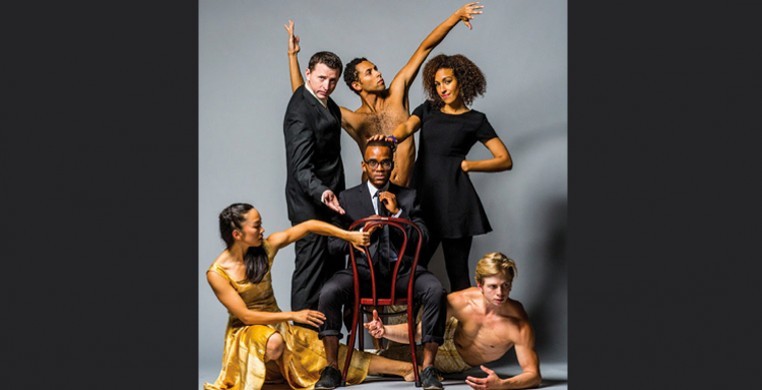Laughing never felt so good, and all the more fun for the surprise of it. You don’t expect to bust a gut at a contemporary dance concert, or to see sketch comedy expand into physical humor on the scale of concert dance. But that was before the wild and crazy creative teams of Hubbard Street Dance Chicago and The Second City joined forces to invent a unique comedy cocktail for their combined hometown audiences. Their fusion of forms, “The Art of Falling,” runs through Sunday at the Harris Theater.
Anything and everything is fair game for this antic crew, from human office furniture to an inflatable date, Swan Lake on wheels and a free-fall bicycle ride. Sight gags abound, but there’s lots more to this show than one-liners and rim-shots.
“The Art of Falling” was a full year in the making and four months in the rehearsal process, and it shows. The care and mutual respect for the unique artistic strengths of their respective disciplines is evident in the structural integrity they achieved. No one could have known that it was a match made in heaven, but the the spirit of play, willingness to take risks, and a comfort level with improvisation they both share all contributed to great chemistry.
Training that emphasizes being receptive to the surprise moment made sparks fly when The Second City and Hubbard Street began collaborating. They found they were not only compatible but combustible, and the happy mutual delirium it has brought about is infectious.
It’s no accident that Viola Spolin’s Theater Games (R) curriculum, from which The Second City sketch comedy form evolved, is based in movement, with an emphasis on creative impulse. “Never say no,” is one of the few game rules that govern its improvisational methodology. “Play the game” is another. The spirit of play is innate in human development and a hallmark of both The Second City’s and Hubbard Street’s rehearsal process, which gave this pairing common ground for collaboration. Play opens the doors for the delight of discovery that made “The Art of Falling” more than just great humor.
HSDC Artistic Director Glen Edgerton and Second City’s Executive Vice President Kelly Leonard brought together five HSDC choreographers, five Second City writers, a stage director, and a musical director to play, explore, and discover, along with five actors and twenty-six dancers. The result is a two-hour production anchored by one major plot-line--dancer meets actor--and three interlocking story scenarios--an office temp in her first day on the job; an airplane conversation turned revelation; and an aging woman’s life commentary. The major stories cycle through the program providing thematic continuity and flow, while in between, smaller, isolated scenes and dance segments keep the show’s pace snappy and add variety.
The Hubbard Street choreographers proved themselves more than up to the task of physical comedy, in dance that magically integrated the fully-staged dramatic action and dialogue of the major plot themes with large ensemble dancing that showcased Hubbard Street’s inventiveness, impressive technical fluidity, and visually striking use of spatial design.
Several all-dance interludes added texture and diversity. Alejandro Cerrudo’s “Typewriter” to a typewriter concerto by Leroy Anderson, was a physical illustration of the music’s perpetuum mobile that brought the house down with mechanical movement as rare and outrageous as its unfathomably complex sequencing and timing, all performed with deadpan determination.
The ultimate bad date played out in Robin Mineko Williams’ “Wicked At Heart,” with Alicia Delgadillo’s inflatable girl pathetically unresponsive to Jason Hortin’s ardent suitor, and Terence Marling’s “White Office Swan” gave us a hilarious “Swan Lake” on rolling swivel office chairs.
Cerrudo’s lyrical excerpt from “Second To Last,” which opened the second half of the program, added a well-placed example of Hubbard Street’s concert repertoire, a series of five abstract duets that explore the dynamics of relationship. How wonderful that this serious concert dance choreography had no trouble coexisting on a program structured around sketch comedy. One reason for this is that each of the rolling comic scenarios was grounded in truthful drama and believable characters that revolved around transformation and the discovery of a basic truth about life, as the best comedy, of course, always is. That this collaboration was able to achieve that depth in a synthesis of disciplines is quite an achievement, and something that has never been done before.
The mutually-administered mind-body transfusion that has taken place between the two companies is a wonder to behold in performance. The level of trust between the thirty-some performers lets this program breathe, and lets the audience relax, and it’s that relaxation that makes both audience and performers completely vulnerable to the humor and the pathos. We become conspirators with the performers, who interact with a whole-body version of a twinkle in their eyes. The laughs sneak up from behind and tap you on the shoulder, or some other body part you weren’t expecting. It’s as if the energy of the dancing has infused the The Second City with its momentum, and the melodies of dialogue-based humor have unleashed Hubbard Street’s inner clown, making the whole much greater than the sum of its parts.
All bets are off as to what they’ll come up with next--and we hope and pray there is a next for this extraordinary experiment. Word is the two-hour program was whittled down from a full eight hours of viable material. Let’s hope those six hours don’t go to waste!

